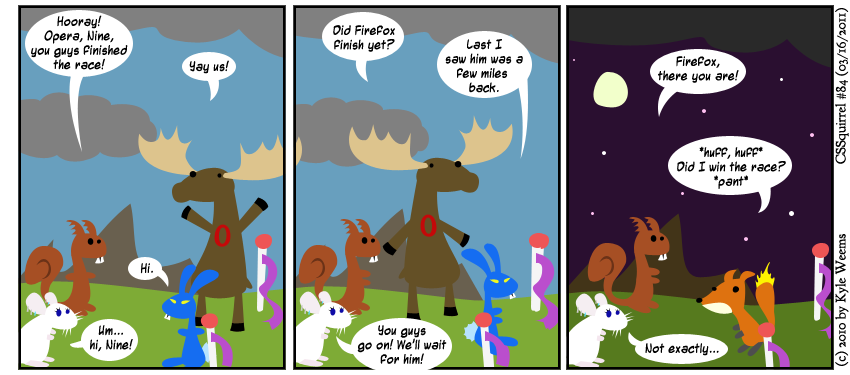Even if haters can’t admit it out loud, they probably need to admit it to themselves deep down inside: Nine is a contender.
For years, Internet Explorer has been out of the game when it comes to any discussion of what constitutes a modern browser. Version 8, as much as it was a drastic improvement over what had come before, was something I viewed more as a correction of 6 and 7′s many errors, and clearly not an effort towards embracing more modern features.
But Nine? Hardware acceleration. A blazingly fast JavaScript engine. Robust CSS3 support (missing things, but includes a decent chunk of what I wanted to see). HTML5 features like <video>, <audio> and even <canvas>. SVG support. On top of it all it’s got a slick, minimalist interface.
Internet Explorer 9 is a modern browser. Period. Dissenters and naysayers are at best nitpicking and at worse lashing out due to old habit.
There are downsides. I wish that they’d made it for XP, but as Microsoft is in the habit of selling operating systems I understand how complex of an issue that might be for their business model. It doesn’t include all the CSS3 I want to see (gradients, anyone?) but they do give a reasonable-sounding reasoning why (ostensibly, they don’t want to add a feature that has to be changed or removed later, and gradients currently have at least two exclusive syntaxes).
But the bottom line is that although IE9 isn’t perfect, it’s also not the flawed, stunted beast of ill-will and developer-consuming horror that its ancestors were. We, as designers, should be grateful that we’ve got another modern browser making our websites look better (and capable of doing more) without requiring us to craft different code for different browsers.
(But feel free to kvetch about the challenge in getting XP users to upgrade to a modern browser. My opinion on that? Tell them to use Chrome or Opera.)
The Orange, Flaming Elephant In The Room
I don’t, as a rule, use Internet Explorer as my daily browser. After all, I want the whole, real web, and historically it was not the best candidate for that. Now that Nine is out, I’ve found in the past couple days that my tolerance levels for my de facto browser, one Mr. Firefox, is suddenly waning.
Firefox is slow.
Today’s comic makes light of this sad, sad bit of information.
Additionally, when using some newer “HTML5″ JS features (such as localStorage) I’ve found Firefox even locking up on what seems like a quick, trivial task for competitors like Chrome. And the old mainstay of my reason to keep Firefox, the plugins, is no longer as unique a feature as it was. I’ve been trying to stick it out until Firefox 4 is released, but I’m losing confidence rapidly in Mozilla’s formerly delicious love child. When using a laptop or trying to quickly load a page to show a friend a neat bit of code or a cute cat video, I’ve lost my patience with Firefox. I’ll fire up Chrome… or Heaven forfend, I’ve even used IE9 in the past day.
I’m not convinced that Internet Explorer’s plunge in its percentage of browser users is going to change yet, despite IE9. I do think, however, that if current trends continue then Firefox is going to find itself facing a plunge of its own while IE’s fortune improves. Of all the modern browsers out there it currently seems to be lagging the most.
That’s right, I said it. I think Firefox is lagging behind Internet Explorer now in terms of modernity.
It’s all well and good to support gradients and other CSS3 features. But right now with the blossoming trend of web apps and the general push to a web-based computer culture, speed is becoming the king of relevance in making a browser worth using. And at the moment, I’m not convinced Firefox 4 is improving enough to close the gap.
Nine isn’t going to be my browser of choice. It’ll take some time yet before Microsoft can convince me to get back to using the big blue e on a regular basis. But its dramatic improvement has made me strongly examine my current browser of choice. I hear Chrome has Firebug.
Good show, Nine. Firefox, time to pony up.
